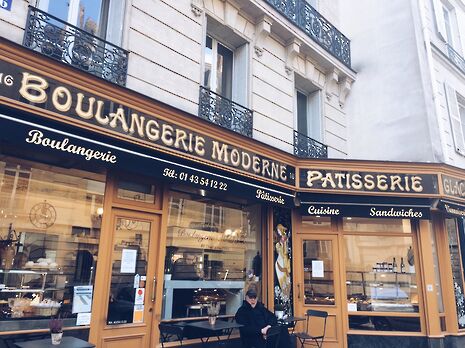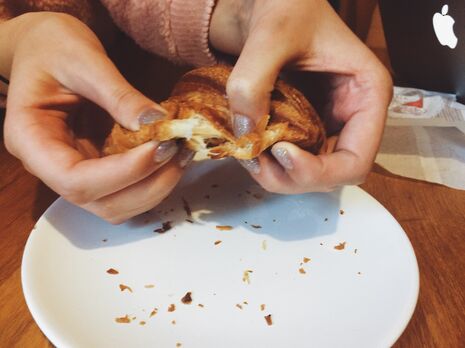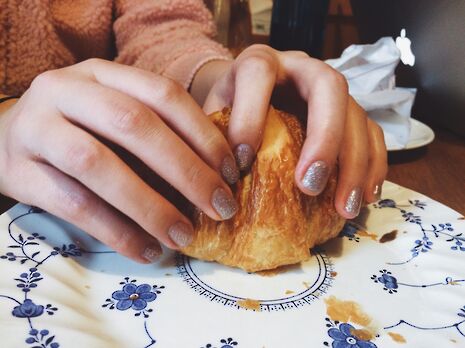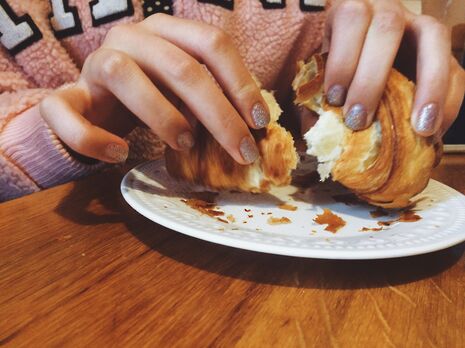
The Cereal Offender: Yay-stry or Nay-stry? Let’s chat about pastry
Xanthe Fuller digs into la pâtisserie

I have so far perhaps neglected to mention that I’m currently on my year abroad in what’s known affectionately by some as ‘the land of the croissant’, and more literally by others as France. Life here’s a piece of gâteau: the food’s good, the wine’s cheap, and people are always impressed if you mention you’re English.
Perhaps my favourite thing, however, about living in Paris, is that every street has at least one bakery, and each bakery releases a golden light, the smell of freshly baked buns, and a long train of people, waiting in line to get their viennoiserie of choice. So today I’m going to discuss an issue very close to my heart: yay-stry or nay-stry? Or, for any Francophones reading this: oui-ennoiserie or ni-ennoiserie? (doesn’t quite work, but I had to try.)
The importance of patisserie to French culture cannot be underestimated. While it is laughable if a British politician has so poor a grasp of the reality of our society to know the average price of a pint of milk, the French ridicule those that do not know the price of a pain au chocolat. This did indeed come to pass in October, when Jean François Copé, a presidential candidate in the right-wing primaries, faced with the pain au chocolat question, stated that they were around 10 or 15 centimes. If only! The average price of a pain au chocolat in a French boulangerie is 1.20€, a monstrous 12 times more than Copé’s guess.
This underestimation shows the sorry state of the world nowadays (that you have to pay so much for a cloud of chocolatey and buttery goodness). Fortunately, hilarity can always be found in such moments. There was a Facebook event that planned to take Copé to a boulangerie to buy him a pain au chocolat – thousands of people said they would attend – as well as a boulanger who created teeny-tiny pain au chocolats that cost 15 cents to make and named them in Copé’s honour. So yes, patisserie is important here, and rightly so.
“There is little I enjoy more than seeing a child excitedly attempting to eat a pain au raisin that is bigger than their face”
I suppose the first question is: do people actually eat pastries for breakfast? It’s pretty hard to tell, but I get the impression that it has a similar status to the Full English, enjoyed every so often but not daily. This is probably for the best, with the amount of butter crammed into these golden goodies: they aren’t the healthiest start to the day, and seem to have retained the status of ‘treat’. Certainly, there is little I enjoy more than seeing a child excitedly attempting to eat a pain au raisin that is as big as, if not bigger than, their face or an elegant woman with a little white paper bag nestled protectively under her arm as if the risk of someone taking it from her is high and constant.
The croissant tends to be seen as the epitome of French-ness, yet it has a far more complicated national identity than that. First things first, the blanket term for pastries in French is ‘viennoiserie,’ which sounds a lot like it has some kind of Austrian heritage, and in fact it does! It’s a descendent of the Kipferl, and was first introduced to France in about 1839, with the founding of the Boulangerie Viennoise in Paris. This pastry inspired many others and soon imitations were everywhere, and it was renamed ‘croissant’ to describe its crescent shape.

This crescent shape is perhaps the most interesting element to discuss. According to legend – and The Oxford Companion to Food by Alan Davidson – the shape of the croissant is inspired by the Islamic crescent shape. This was due to the Ottoman siege of either Buda or Vienna (wonderfully historically precise, you’re welcome), where a baker in his underground kitchen felt rumbling and heard foreign voices nearby, thereby discovering a tunnel forged by the Ottoman forces and saving his city (a classic fairy story). This inspired a baking trend of these victory pastries, made in the shape that dominated the Ottoman flag. If you can’t rub a military victory in through a baked good, then, how can you? Thus, the croissant has a far less friendly and more international past than one would have thought.
Now that we know about the darker side of the croissant, we might as well find out how to differentiate between a ‘good’ one and a ‘bad’ one. With a quick google search under my belt, I can provide you with a definitive list of things to consider when buying/eating a croissant, so that you can have the necessary know-how when it comes to baked goods:
- Le feuilletage, AKA the layers of pastry: they should be visible and plural
- The lovely soft bit in the middle should be a little bit elastic but not too doughy, and there should be crumbs when you dig in
- The weight: it should be as light as a very light feather
- The sound: there is nothing to be avoided more than a silent croissant, and by silent, I mean lacking in crunch or crackle upon chomping
- The taste – obviously – but really, what is meant is that you should taste the fact that this simple pastry contains your weight in butter, folded into the layers. Don’t shy away from it: rejoice in the dairy
- Apparently, there are also things to avoid, so you can separate the croissant from the not-for-moi-ssant. No one wants a white bottom and the soggy kind is even less desirable. Croissants need curves; steer clear of any flat ones

We did a little taste test of three croissants from three different establishments applying the aforementioned rules and found, much like goldilocks, that one was too crispy on the outside, one was organic but too soft, and the last one was just right – it was golden, curvy and the right kind of flaky.
To conclude. We have learned many things today: that pastry and religion are – as I had always surmised – linked, that you never want a flat croissant with a pale behind and that politicians rarely know the price of key grocery products. And this whole exercise has only confirmed to me that they’re not just a baked good, they’re a baked great.

The Cereal Box: Weetos
Maintaining the theme of lavish breakfasts established by the whole pastry section, the cereal under scrutiny this week is the Weeto. Owned by the same company as Weetabix, it follows an equally literal naming system – a wheat-based cereal in an O shape – with the commendably trendy and youthful choice of ‘weet’ over ‘wheat’. These are, however, not just any wheaty O-shaped cereal. Oh no, they’re more than just a Cheerio – they’re covered with lashings of chocolate.
Now, there are two strategies to eating the humble Weeto, in my experience. Either you eat the little surprised puffs as soon as possible, where cereal-eating becomes a race against the clock in order to retain the crunch (crunch time is the crunch time). Or, you strategically leave them a bit so they get a bit soggy, but then bask in the glory that is the chocolate milk left in the soggy cereal’s wake.
I, myself, subscribe to the first school of thought, keep the cereal crunchy and leave the milk as it was intended, but some only see the Weeto for its chocolate milk potential, so prefer the second method of consumption.
Back in the day, there was more to Weetos than cereal. They used to give out mascots. There was nothing more joyful than pouring out your Weetos in the morning to find a little troll figure cartwheel into your bowl. Sadly, I fear that health and safety may have kicked in and they are afraid that the children of today will inhale the aforementioned troll, rather than be overjoyed at their luck. How sad for the children of today.
Weetos can be what you want them to be: crunchy, soggy, chocolate-milky. The power’s in your hands. Enjoy

